REVIEW: ASG Cobray Ingram M11 (Non-blowback) Air Pistol
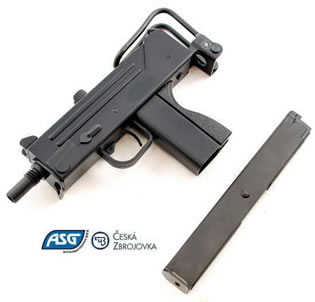
This authentic M-11 is fully licensed by Cobray. The real steel M-11 was renowned as one of the fasted shooting machine pistols ever made. Able to shoot 32 rounds in under 2 seconds though, it was hardly accurate. Thankfully ASG slowed things way down with this semi-auto M-11. Now you can place your 39 shots onto soda cans and paper targets to your heart’s content. Simply load up your BBs and CO2 into the magazine, slap it home and blast away. Each M-11 featuring a folding stock for added realism and accuracy. It’s a gun that’s built for hours of shooting fun, so lock, load and put 39 BBs into the air as fast as you can pull the trigger.
|
Airgun Specifications:
|
Airgun Features:
|
More information about this product.
Additional ASG Cobray Ingram M11 Submachine BB Gun Photos

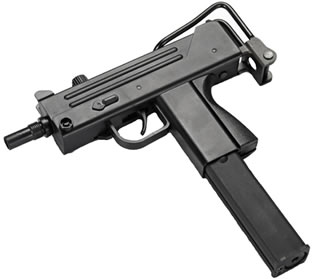
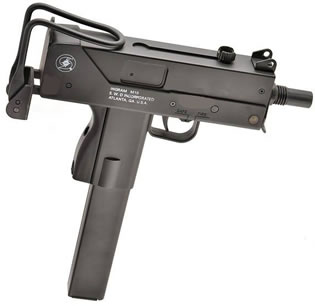
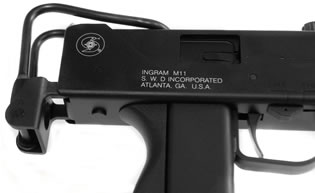
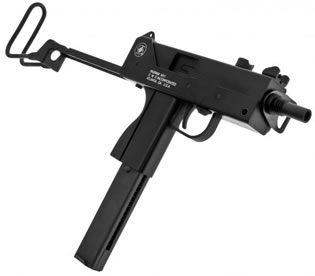
Amazon.com Product and Customer Reviews
Most helpful customer reviews
0 of 0 people found the following review helpful.
![]() Five Stars
Five Stars
By Andrew S Taylor
Works great! I love it.
0 of 1 people found the following review helpful.
![]() I opened my package and it was broken,
I opened my package and it was broken,
By Spencer Lewis
I opened my package and it was broken , not there fault but I should of kept it and sent it back instead of throwing it all away
0 of 0 people found the following review helpful.
![]() Very fun
Very fun
By Amazon Customer
Not fully auto but still a bitching gun!
If people still say that
Very powerful will take paint off car doors
Smaller metal BB
History behind the firearm that inspired the ASG Cobray Ingram M11 Airgun
 The Ingram MAC-11 (Military Armament Corporation Model 11) is a subcompact machine pistol developed by American gun designer Gordon Ingram at the Military Armament Corporation (MAC) during the 1970s. The weapon is a sub-compact version of the Model 10 (MAC-10), and is chambered to fire the smaller .380 ACP round. This weapon is sometimes confused with the Sylvia & Wayne Daniels M-11/9 or the Vulcan M-11-9, both of which are later variants of the MAC chambered for 9 mm Luger Parabellum cartridge. Cobray also made a .380 ACP variant called the M12.
The Ingram MAC-11 (Military Armament Corporation Model 11) is a subcompact machine pistol developed by American gun designer Gordon Ingram at the Military Armament Corporation (MAC) during the 1970s. The weapon is a sub-compact version of the Model 10 (MAC-10), and is chambered to fire the smaller .380 ACP round. This weapon is sometimes confused with the Sylvia & Wayne Daniels M-11/9 or the Vulcan M-11-9, both of which are later variants of the MAC chambered for 9 mm Luger Parabellum cartridge. Cobray also made a .380 ACP variant called the M12.
Operation: Like the larger M-10, the M-11 has open sights with the rear pinhole sight welded to the receiver. These sights are for use with the folding stock, as using them without the stock is nearly useless because of the initial jump of the weapon due to its heavy, open-bolt design. The M-11A1 also has two safety features which are also found on the Model 10A1. The charging handle rotates to 90 degrees to lock the bolt in the forward position thus preventing the weapon from being cocked. The second safety is a slider which is pushed forward to lock the trigger, which in turn pins the bolt to the rear (cocked) position. This prevents the weapon from discharging even when dropped, which is not uncommon with an open-bolt design.
 Performance: Semi-automatic, Cobray MAC-11/9 with 32-round magazine and suppressor. The rate of fire of the M-11A1 is one of the biggest complaints on the firearm. Listed as approximately 1,200 rpm (rounds per minute), the MAC-11 is capable of emptying the entire 32-round magazine in less than two seconds, which many users view as a drawback. Rate of fire will also vary depending on the weight of bullets used. The gun also has a selector switch that allows it to fire only one round at a time in the semi-automatic mode. Noting the weapon's poor accuracy, in the 1970s International Association of Police Chiefs weapons researcher David Steele described the MAC series as "fit only for combat in a phone booth.
Performance: Semi-automatic, Cobray MAC-11/9 with 32-round magazine and suppressor. The rate of fire of the M-11A1 is one of the biggest complaints on the firearm. Listed as approximately 1,200 rpm (rounds per minute), the MAC-11 is capable of emptying the entire 32-round magazine in less than two seconds, which many users view as a drawback. Rate of fire will also vary depending on the weight of bullets used. The gun also has a selector switch that allows it to fire only one round at a time in the semi-automatic mode. Noting the weapon's poor accuracy, in the 1970s International Association of Police Chiefs weapons researcher David Steele described the MAC series as "fit only for combat in a phone booth.
Acceptance: The M-11 is the least common version in the MAC family of firearms. At the MAC-11's high cyclic rate, extreme trigger discipline is required to discharge short bursts, which are required for combat expediency. Without proper training, the natural tendency of the inexperienced shooter is to hold down the trigger, discharging the entire magazine in little more than two seconds, often with poor accuracy due to recoil.
Manufacturers: MAC-type submachine guns and semi-automatic pistols were first manufactured by the Military Armament Corporation, and later by RPB Inc., Sylvia/Wayne Daniel Inc., Cobray, Jersey Arms, Leinad, MasterPiece Arms, and Vulcan.
Sound suppressor: A specific suppressor was developed for the MAC-11, which used wipes as baffles, instead of the reflex baffles that Mitchell Werbell III created for the MAC-10. Though wipes are less durable than reflex baffles, they had the advantage of proving quieter for the MAC-11. The suppressor is 224mm in length and is covered with Nomex-A heat-resistant material.
